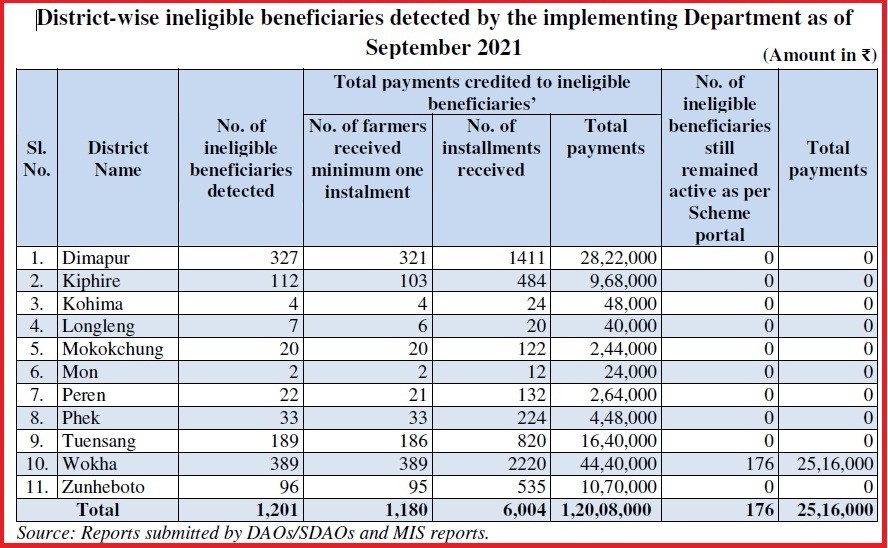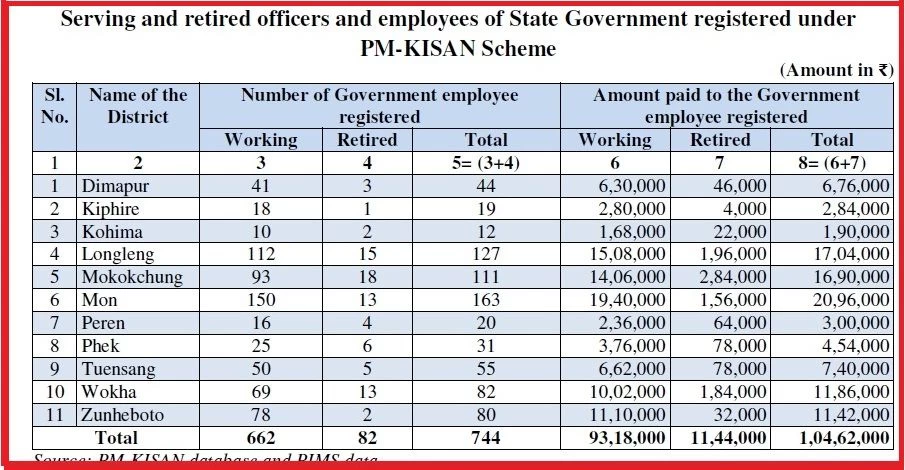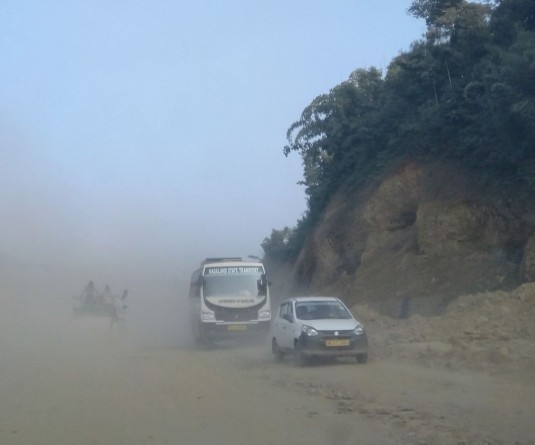Source: Comptroller and Auditor General of India (CAG) report on Social, Economic, General and Revenue Sectors (For the year ended 31 March 2022)

Implementation fraught with shortcomings
Morung Express News
Dimapur | September 15
Even dead people as well as ineligible in-services and retired government employees were registered as beneficiaries of the Pradhan Mantri-Kisan Samman Nidhi (PM-Kisan) Scheme in Nagaland, revealed the ‘Performance Audit’ report by the CAG.
Cross-verification of the Personal Information Management System (PIMS) and beneficiaries data revealed that that 662 out of 9,951 in-services and 82 out of 1,854 retired Government employees who were ineligible were registered as beneficiaries, it said.
As a result, Rs 1.05 crore was paid (up to September 2021) to ineligible beneficiaries, added the "Comptroller and Auditor General of India (CAG) report on Social, Economic, General and Revenue Sectors (For the year ended 31 March 2022)" tabled in the NLA on September 14.
Even dead people were getting benefits, the report highlighted, citing examination of Management Information System (MIS) reports of the scheme on September 2021.
There were 108 inactive beneficiaries due to death, out of which deaths of 86 were uploaded in the portal while the dates for the remaining 22 beneficiaries were not available, it said.
Further analysis revealed that 132 installments of Rs 2.64 lakh were credited to bank accounts of 43 beneficiaries even after their death.
The time taken by the respective offices to upload death cases in the scheme portal ranged from 25 to 868 days from the date of death of the beneficiaries, the CAG noted, and the delay resulting in credit of installments after death.
According to the report, in reply to the findings, the State Government stated (December 2021) that the matter will be verified as per the observation of Audit and necessary recovery process initiated.

Multiple beneficiaries with same bank account & mobile nos
The audit further noticed that 14 bank IFSC and Bank account numbers were linked with 28 beneficiaries, out of which 27 beneficiaries were “Active,” indicating that they could avail the financial assistance.
It was observed that 24 out of 28 received at least one installment amounting to Rs 2.78 lakh. Further, 55 bank account numbers with different IFSCs were linked with 110 beneficiaries and 109 beneficiaries were “Active.”
Incidentally, though having same bank accounts, the beneficiaries were shown to be spread over Kiphire, Peren, Tuensang, Wokha, and Zunheboto.
Analysis of beneficiary database revealed that multiple mobile numbers were provided by 8,191 beneficiaries. Multiple beneficiaries with the same mobile number is a red flag and requires further detailed verification of their eligibility, the CAG said.
Overall, Rs 2.36 crore was paid to 2,053 ineligible beneficiaries which was yet to be recovered, the report said.
Meanwhile, according to the CAG, 657 ineligible beneficiaries were detected through the involvement of other stakeholders such as destination banks and the VCs in Dimapur and Wokha.
The practices followed by Wokha and Dimapur districts in verification of eligibility of beneficiaries may be adopted in the remaining districts to weed out ineligible beneficiaries, it added.
Genuine beneficiaries ‘deprived’
Incidentally, while ineligible beneficiaries were getting benefits, some genuine applicants were rejected due to incorrect entries of unique biometric identity, bank account numbers, farmers’ names etc.
Examination of data/ reports from the portal indicated lack of appropriate input controls, the CAG said. Such invalid entries will compromise the authenticity and integrity of the database and further beneficiaries also will be unable to avail scheme benefits, it said.
Instances included 107 beneficiaries yet to receive any payment as gender value uploaded was ‘Null’ (it should be M/F/T); or while 401 farmers were yet to receive benefits due to wrong data entry by the State Government officials.
Benefits were discontinued after November 2019 in respect of 9,039 farmers as their names did not match with unique biometric identity and 9,734 farmers unique biometric identity were not authenticated.
The State Nodal Officers, however, did not communicate these shortcomings to the stakeholders and share the list of the rejected data to enable them to submit or update the corrected data in the portal, it added.
The government accepted the facts on December 2021 and said that more efforts will be put in to accurately capture the farmers’ attributes in the PM-KISAN database. The CAG also directed the department to incorporate appropriate input control/ validation to ensure correctness of data.
Other shortcomings
The ‘Performance Audit on implementation of PM-Kisan Scheme in Nagaland, covered the period from 2018-19 to 2020-21. The scheme is a central sector scheme with 100% funding by Government of India and implemented under Direct Benefit Transfer (DBT) mode.
Under the scheme, among others, eligible farmers are provided financial benefit of Rs 6,000 per annum per farmer family payable in 3 equal instalments every 4 months.
A sample comprising of 4 districts, eight blocks and 24 villages, among others, were selected based on Stratified Random Sampling for the audit in Nagaland.
According to the report, out of 3, 44,983 applications uploaded, 2,13,682 applications were accepted, while 71,196 applicants were rejected as they were either ineligible (68,684) or had furnished incomplete details (2,512).
Applications of 60,105 self-registered farmers were pending for approval by the implementing department while new registration of beneficiaries was temporarily suspended in March 2020 by the implementing department as the State had achieved the overall saturation target.
Though the State Government achieved the target, the implementation of the scheme was fraught with shortcomings, the CAG noted. Among others, beneficiary lists were prepared without any checks and balances while ownership of cultivable land of beneficiaries was not verified.
The beneficiaries also did not correlate with the Nagaland Agriculture Census 2015-16, while no landholding records were maintained at the village level, it added.
Temporary suspension of new registrations deprived 23,144 beneficiaries of the scheme benefits in 4 test-checked districts, the report said.
While Review or Monitoring Committees were not constituted, there were delays in constitution of Grievance Redressal Monitoring Committees, it said.
Recommendations
The CAG recommended that the State Government identify eligible beneficiaries and accordingly sanitise the database as per the scheme guidelines. Self-declarations and ownership of cultivable land of beneficiaries as envisaged in the Operational Guidelines should be ascertained, it said.
Besides, it called for 100% validation of bank accounts and updating the Optional Attributes such as Father’s/ Husband’s name, mobile number, date of birth, landholdings, etc
Conduct state-wide verification of beneficiaries by involving destination banks and VCs to weed out ineligible beneficiaries, the CAG advised.
It also urged steps to fix responsibility for non-verification of applications submitted as well as recovery of amounts unduly credited to ineligible beneficiaries.
Further, it advised strengthening the grievance redressal mechanism to ensure resolution of complaints as per the scheme guidelines and conduct social audit.






